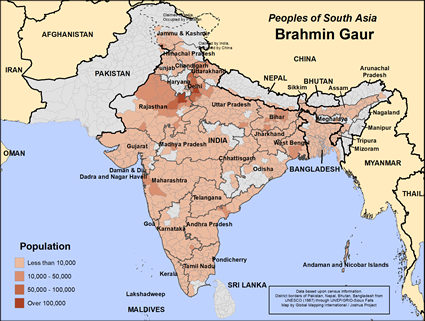Brahmans (often in the past spelled Brahmins) are the highest of the four varna (major caste groupings) in Hinduism. The historical developments of various Brahman castes are not clear, as the history of the caste system itself is unclear. There was perhaps a caste system based on personal merit at one time before the hereditary caste system became dominant, as is seen in modern history. Brahman castes became powerful in the early centuries of the Christian Era through alliances with kings, who granted them landed estates related to temples and temple service. There has never been a comprehensive analysis of all the different types and subgroups of Brahmans.
Traditionally Brahmans have five daily duties; to the gods, to ancestors, to all creatures, to humans, and to study. Thus daily worship (duty to gods) and chanting of sacred texts (duty to study) are an integral part of many Brahmans' lives, even if this is only a token routine for many.
Brahmans are scattered across India and Nepal in dozens of jātis (castes) speaking many different languages. A high percentage of them also speak English as higher education in India is mostly English medium.
Brahmans are disproportionately represented among overseas Indians and Nepalis due to their higher educational attainments, so those who reach out to Indian nationals in the West are very likely reaching out to people who are extremely difficult to reach in South Asia.
Traditionally in the varna system Gaur Brahmans are considered as priests, but a temple priest is a lowly position that no Brahman family wants their sons to aspire towards. Rather, there is strong pressure for higher education, particularly in computer science and engineering. Brahmans have a strong work ethic and are often leaders, whether politically, intellectually, spiritually or socially.
Gaur Brahmans are still deeply influenced by the traditional four stages of life; the first student stage is followed by the householder stage, where marriage, raising a family and being a productive member of society is the primary obligation of an individual. Once children are married there is time for spiritual concerns in the third stage of reclusiveness, which is followed (this is rarely practiced) by itinerant homeless wandering (sannyasa).
Often a busy Gaur Brahman will put off spiritual discussions as an issue for later in life. The famous Bhagavad Gita text does not support this, however, as it calls for all humanity to engage in doing good to all without thought of merit or reward for such actions.
In some cases Brahman subgroups are defined by their theological distinctions such as Madhva Brahmans, who are defined by their dualist theology, though everyone does not actually hold those beliefs. However, many Brahman castes are made up of people who adhere to all the various philosophical and theological options espoused by modern Hindus, including hard core secularists and atheists. One can never predict what an individual Brahman might believe or disbelieve!
The Gaur Brahmans as an influential and generally well-to-do community are not unlike the middle classes of most places. Their main needs involve relational strains that are usually kept behind closed doors. Modernization is breaking down family units which have been the glue to society for many generations, and loneliness is increasingly a problem. They are expected to "achieve it all," but ironically, achieving it all can be empty.
Pray for Christ to reveal Himself to Gaur Brahman leaders.
Pray for the eyes of Gaur Brahman hearts to be open to Jesus Christ as Lord and king.
Pray for Holy Spirit directed Christ followers to go to Brahman communities.
Pray for a disciple making movement to emerge among every Brahman community.
Pray for many to be prompted to faithfully pray for Gaur Brahmans.
Scripture Prayers for the Brahmin Gaur in Nepal.
https://joshuaproject.net/people_groups/19943/IN
https://www.britannica.com/topic/Brahman-caste
https://en.wikipedia.org/wiki/Brahmin
http://www.outlookindia.com/magazine/story/brahmins-in-india/234783
https://joshuaproject.net/people_groups/16521/IN
http://induhistory.blogspot.com/p/brahmins-history.html
http://traceyourlineage.blogspot.com/2008/04/origin-of-gotras.html
https://thehindus.org/faqs/what-types-of-brahmins-are-there/
http://hinducaste.blogspot.com/2009/06/divisions-among-brahmins.html
| Profile Source: Keith Carey |











